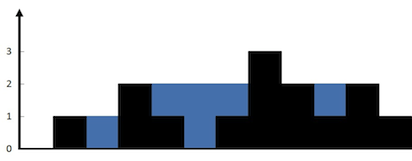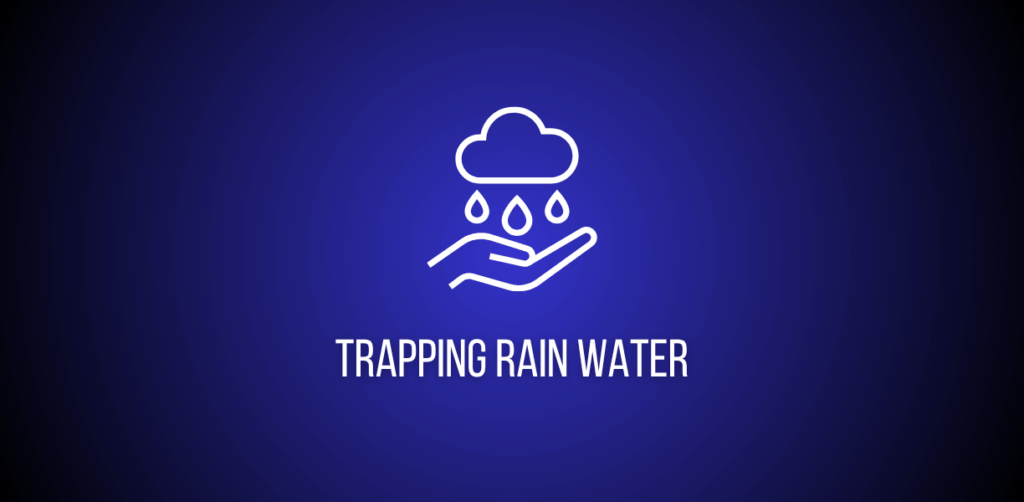Given n non-negative integers representing an elevation map where the width of each bar is 1, compute how much water it can trap after raining.
Here’s the [Problem Link] to begin with.
Example 1:

Input: height = [0,1,0,2,1,0,1,3,2,1,2,1]
Output: 6
Explanation: The above elevation map (black section) is represented by array [0,1,0,2,1,0,1,3,2,1,2,1]. In this case, 6 units of rain water (blue section) are being trapped.
Example 2:
Input: height = [4,2,0,3,2,5]
Output: 9
Constraints:
n == height.length1 <= n <= 2 * 1040 <= height[i] <= 105
Contents:
[show]
Brute Solution: Prefix and Suffix Arrays
Intuition and Approach
- For each position i, find:
- The tallest bar on the left up to i (call it prefixMax[i]).
- The tallest bar on the right from i to the end (call it suffixMax[i]).
- Water at position i is limited by the shorter side among these two maxima.
- So, water at i = min(prefixMax[i], suffixMax[i]) − height[i].
- Add this for all positions to get the total trapped water.
Why it works:
- Water can only stand up to the height of the shorter wall among left and right sides.
- Precomputing both sides for every index makes calculation straightforward.
Code Implementation
class Solution:
def trap(self, height: List[int]) -> int:
if not height or len(height) < 3:
return 0
n = len(height)
# Initialize prefixMax and suffixMax arrays.
prefixMax = [0] * n
suffixMax = * n
# Fill the prefixMax array (tallest from the left up to i).
prefixMax = height
for i in range(1, n):
prefixMax[i] = max(prefixMax[i - 1], height[i])
# Fill the suffixMax array (tallest from the right from i to end).
suffixMax[n - 1] = height[n - 1]
for i in range(n - 2, -1, -1):
suffixMax[i] = max(suffixMax[i + 1], height[i])
# Calculate the total water trapped.
trapped_water = 0
for i in range(n):
# Water at i is the difference between the limiting wall and bar height.
trapped_water += min(prefixMax[i], suffixMax[i]) - height[i]
return trapped_waterCode Explanation
- We first compute the tallest bar to the left for each index (prefixMax).
- Then we compute the tallest bar to the right for each index (suffixMax).
- For each index, the water is the smaller of these two heights minus the actual bar height.
- Summing across all indices gives total trapped water.
Time and Space Complexity
- Precise: Time O(n + n + n) = O(3n), Space O(2n).
- Simplified: Time O(n), Space O(n).
Conclusion
- Very easy to understand and implement.
- Uses extra memory for two arrays, but logic is simple and reliable.
Better Solution: One Suffix Array + Running Left Max
Intuition and Approach
- We can avoid storing both arrays.
- Precompute only right-side maxima in an array (rightMax).
- As we scan from left to right, keep a running leftMax.
- Water at i = min(leftMax, rightMax[i]) − height[i].
Why it works:
- You still need both left and right maxima for each position.
- The left maximum can be kept as a single number updated as we move forward.
Code Implementation
from typing import List
class Solution:
def trap(self, height: List[int]) -> int:
n = len(height)
if n < 3:
return 0
# rightMax[i] = max(height[i..n-1])
rightMax = [0] * n
rightMax[-1] = height[-1]
for i in range(n - 2, -1, -1):
rightMax[i] = max(rightMax[i + 1], height[i])
trapped = 0
leftMax = 0
for i in range(n):
# Update leftMax up to current i
leftMax = max(leftMax, height[i])
# Water at i is limited by the lower of leftMax and rightMax[i]
trapped += min(leftMax, rightMax[i]) - height[i]
return trappedCode Explanation
- We compute rightMax once by scanning from right to left.
- We maintain leftMax on the fly while scanning from left to right.
- At each index, the smaller of leftMax and rightMax[i] determines the water level.
Time and Space Complexity
- Precise: Time O(n + n) = O(2n), Space O(n).
- Simplified: Time O(n), Space O(n).
Conclusion
- Same core idea as Brute, but saves memory by avoiding the full left array.
- A nice balance between simplicity and space saving.
Optimal Solution: Two-Pointer Technique
Intuition and Approach
- The side with the smaller current height limits the water.
- Use two pointers:
- left at the start, right at the end.
- leftMax stores the tallest seen so far from the left.
- rightMax stores the tallest seen so far from the right.
- Move the pointer on the smaller side inward:
- If height[left] < height[right]:
- If height[left] < leftMax, water += leftMax − height[left].
- Else update leftMax.
- Move left forward.
- Else do the symmetric steps on the right.
- If height[left] < height[right]:
Why it works:
- The water at the smaller side depends only on that side’s max, not on the far side.
- This lets us decide locally which pointer to move and how much water to add, in one pass.
Code Implementation
class Solution:
def trap(self, height: List[int]) -> int:
# Edge case: If the height list is empty or has less than 3 elements, no water can be trapped.
if not height or len(height) < 3:
return 0
# Initialize two pointers and variables to keep track of maximum heights.
left, right = 0, len(height) - 1
leftMax, rightMax = 0, 0
trapped_water = 0
# Traverse the elevation map using two pointers.
while left < right:
# Compare the heights at both pointers.
if height[left] < height[right]:
# Calculate water trapped at the left index.
if height[left] >= leftMax:
leftMax = height[left] # Update leftMax.
else:
trapped_water += leftMax - height[left] # Water trapped.
left += 1 # Move left pointer to the right.
else:
# Calculate water trapped at the right index.
if height[right] >= rightMax:
rightMax = height[right] # Update rightMax.
else:
trapped_water += rightMax - height[right] # Water trapped.
right -= 1 # Move right pointer to the left.
return trapped_waterCode Explanation
- We always process the side that is shorter because that side limits the water level there.
- If the current bar on that side is lower than the recorded max for that side, the difference is the water trapped on top of that bar.
- This avoids building any extra arrays and finishes in one pass.
Time and Space Complexity
- Precise: Time O(n), Space O(1).
- Simplified: Fastest and most memory-efficient.
Conclusion
- Best approach for interviews and production use.
- Minimal memory, single scan, clean logic once you know the insight.
Final Takeaways
- Water at a position depends on the shorter of the tallest bars to its left and right.
- Brute: Two arrays (easiest to grasp).
- Better: One array + running left max (saves memory).
- Optimal: Two pointers (fastest and least memory).
For any changes to the article, kindly email at code@codeanddebug.in or contact us at +91-9712928220.
